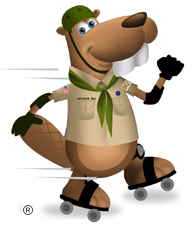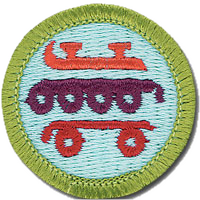Skating


Resources
- Skating Class Preparation Page - for all options
- Skating Workbook - Ice Skating Option
- Skating Workbook - In-Line Skating Option
- Skating Workbook - Roller Skating Option
- Skating Workbook - Skateboarding Option
- Scoutmaster Bucky's Merit Badge Advancement Quick Reference
- Scoutmaster Bucky's Acknowledgement Form
Skating Requirements Current Scouts BSA requirements
as of May 26, 2025
as of May 26, 2025
1.
Do the following:
a.
Explain to your counselor the most likely hazards associated with
skating and what you should do to anticipate, help prevent, mitigate,
and respond to these hazards.
b.
Show that you know first aid for injuries or illnesses that could
occur while skating, including hypothermia, frostbite, lacerations,
abrasions, fractures, sprains and strains, concussions, blisters,
heat-related reactions, and shock.
2.
Working under the supervision of an experienced adult, do ONE of the
following options.
Option A: Ice Skating
a.
Do the following:
1.
Give general safety and courtesy rules for ice skating. Discuss
preparations that must be taken when skating outdoors on natural
ice. Explain how to make an ice rescue.
2.
Discuss the parts and functions of the different types of ice
skates.
3.
Describe the proper way to carry ice skates.
4.
Describe how to store ice skates for long periods of time, such as
seasonal storage.
b.
Do the following:
1.
Skate forward at least 40 feet and come to a complete stop. Use
either a two-foot snowplow stop or a one-foot snowplow stop.
2.
After skating forward, glide forward on two feet, then on one foot,
first right and then left.
3.
Starting from a T position, stroke forward around the test area,
avoiding the use of toe picks if wearing figure skates.
c.
Do the following:
1.
Glide backward on two feet for at least two times the skater's
height.
2.
Skate backward for at least 20 feet on two skates.
3.
After gaining forward speed, glide forward on two feet, making a
turn of 180 degrees around a cone, first to the right and then to
the left.
d.
Do the following:
1.
Perform forward crossovers in a figure-eight pattern.
2.
Explain to your counselor the safety considerations for
participating in an ice-skating race.
3.
Perform a hockey stop.
Option B: Roller Skating
a.
Do the following:
1.
Give general safety and etiquette rules for roller skating.
2.
Discuss the parts and functions of the roller skate.
3.
Describe five essential steps to good skate care.
b.
Do the following:
1.
Skate forward with smooth, linked strokes on two feet for at least
100 feet in both directions around the rink and demonstrate proper
techniques for stopping.
2.
Skate forward and glide at least 15 feet on one skate, then on the
other skate.
c.
Do the following:
1.
Perform the forward crossover.
2.
Skate backward for at least 40 feet on two skates, then for at
least 15 feet on one skate.
3.
Skate forward in a slalom pattern for at least 40 feet on two
skates, then for at least 20 feet on one skate.
4.
Skate backward in a slalom pattern for at least 15 feet on two
skates.
d.
Do the following:
1.
Shuttle skate once around the rink, bending twice along the way
without stopping.
2.
Perform a series of two consecutive spins on skates, OR hop, skip,
and jump on skates for at least 10 feet.
e.
Do the following:
1.
Race on a speed track, demonstrating proper technique in starting,
cornering, passing, and pacing.
2.
Perform the limbo under a pole placed at least chest-high, OR
shoot-the-duck under a waist-high pole and rise while still on one
foot.
3.
Perform the stepover.
4.
While skating, dribble a basketball the length of the floor, then
return to your starting position, OR push a hockey ball with a
stick around the entire rink in both directions.
Option C: In-Line Skating
a.
Do the following:
1.
Give general and in-line skating safety rules and etiquette.
2.
Describe the parts and functions of the in-line skate.
3.
Describe the required and recommended safety equipment.
4.
Describe four essential steps to good skate care.
b.
Do the following:
1.
Skate forward with smooth, linked strokes on two feet for at least
100 feet.
2.
Skate forward and glide at least 15 feet on one skate, then on the
other skate.
3.
Stop on command on flat pavement using the heel brake.
c.
Do the following:
1.
Perform the forward crossover.
2.
Perform a series of forward, linked swizzles for at least 40 feet.
3.
Skate backward for at least 40 feet in a series of linked, backward
swizzles.
4.
From a strong pace, perform a lunge turn around an object
predetermined by your counselor.
5.
Perform a mohawk.
d.
Do the following:
1.
Perform a series of at least four one-footed downhill slaloms on
pavement with a gentle slope.
2.
Describe how to pass a pedestrian or another skater from behind.
3.
Describe at least three ways to avoid an unforeseen obstacle while
skating.
4.
Describe two ways to get on and off a curb, and demonstrate at
least one of these methods.
Option D: Skateboarding
a.
Explain the following to your counselor:
1.
History and evolution of skateboarding
2.
Benefits of skateboarding (physical fitness, balance, coordination,
perseverance, and creativity)
3.
Purpose of skateboarding safety and protective gear (helmets, knee
pads, elbow pads, wrist guards).
b.
Explain the following to your counselor:
1.
Rules and regulations of skateparks
2.
Understanding skatepark zones (street, bowl, and ramp)
3.
Right-of-way and respect for others
4.
Communication signals and warnings.
c.
Do the following:
1.
Explain skateboard anatomy (deck, trucks, wheels, bearings)
2.
Build a board by assembling all pieces (deck, wheels, trucks,
bearing, and grip tape) in the proper order
3.
Explain skateboard maintenance (cleaning, tightening bolts, and
replacing parts)
d.
Demonstrate the following skateboarding skills:
1.
Stance and foot placement (regular and goofy)
2.
Pushing and balance
3.
Turning and carving
4.
Braking and stopping techniques
5.
Ollies (basic and variations).
e.
Demonstrate a total of three skateboarding tricks from the following
types:
1.
Flatland tricks
2.
Flip and shove-it tricks
3.
Grind and slide tricks
4.
Air, grab, bowl and ramp tricks
5.
Footplant tricks
6.
Balance tricks.

